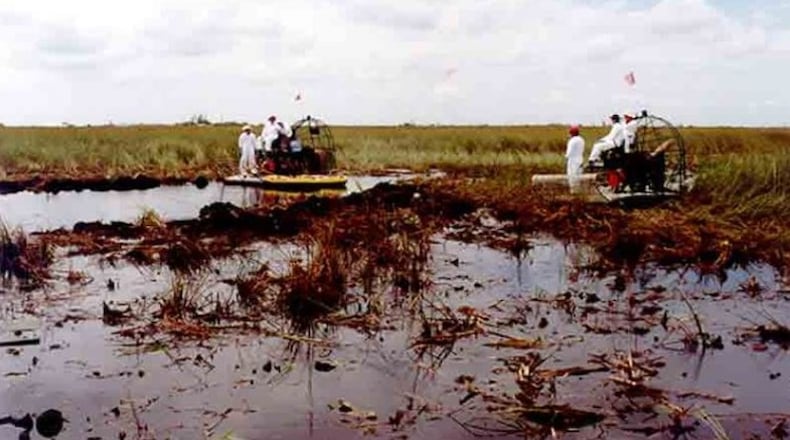Nearly one-third of the 110 passengers aboard ValuJet Flight 592 were from metro Atlanta and returning home from Miami when the plane crashed into the Florida Everglades on May 11, 1996.
There were no survivors.
The crash happened on a Saturday afternoon, the day before Mother’s Day.
About six minutes after takeoff, the pilots reported hearing a loud bang.
Next, passengers began smelling smoke.
Moments later, the pilot radioed air traffic control at Miami International Airport that the plane was circling back because of an apparent fire in the passenger cabin.
Confusion, panic and mayhem set in as smoke began billowing into the cockpit.
For reasons that were not immediately known, the plane had become a death ship and was quickly losing altitude.
By 2:13 p.m., Flight 592 had disappeared from radar.
The entire tragic chain of events unfolded in only about 10 minutes.
‘WE KNOW THERE’S NO HOPE,’ blared the headline on the next day’s front page of The Atlanta Journal-Constitution — which was a quote by a surviving family member who came to Hartsfield International Airport to await word on the fate of his loved ones.
A 15-month investigation by the National Transportation and Safety Board revealed the cause of the crash — a fire had erupted in the jet’s cargo hold, fueled by a load of surplus oxygen canisters that a maintenance contractor removed from a different jet then reloaded onto Flight 592.
Unfortunately the tanks were brought on board without safety caps to prevent them from igniting, and some were sparked by the jostling of the aircraft during takeoff.
The aftermath
The plane nosedived into the Francis S. Taylor Wildlife Management Area in the Everglades, a few miles west of Miami.
It took several weeks to locate only some of the remains of the passengers and crew, with recovery teams in airboats and helicopters slowed by the hostile wetlands where the plane had nose-dived. The investigation found that some of the dead were scavenged by wildlife, while many other victims were likely swallowed by the swamp upon impact.
Only around 68 of the 110 people who perished were ultimately found and identified, according to reports.
The crash led to more scrutiny of smaller, fast-growing carriers, and to rules requiring smoke detectors in the cargo holds of smaller or older jets that did not have to have them previously.
The government grounded ValuJet before allowing it back in the air on Sept. 30, 1996. About a year later, ValuJet merged with a smaller carrier, Florida-based AirTran, adopting its name but keeping Atlanta as its main hub. With a new image and improved safety, the company grew into a national power.
In 2011, Dallas-based Southwest Airlines bought AirTran and now flies many of its old routes from Hartsfield-Jackson International Airport.
Did anyone face charges?
In April 2018, the FBI announced a $10,000 reward for an airline mechanic with Atlanta ties alleged to have played a role in the crash. Mauro Ociel Valenzuela-Reyes, who worked for the airline’s maintenance contractor, SabreTech, remains a fugitive and faces federal criminal charges after crash investigators determined he mishandled oxygen generators that were placed in the DC-9′s cargo hold.
Those who were lost
The flight manifest revealed the names of all those aboard the DC-9 bound for Atlanta, including those whose remains were never found.
Songwriter and musician Walter Hyatt was on board; also San Diego Chargers running back Rodney Culver, who was heading home to see his kids in Woodstock, just north of Atlanta.
A bombshell name on the list was DelMarie Walker — an Atlanta mother under investigation for murder.
Here are more about their stories:
Atlanta-area family gone
The McNitt family of Powder Springs — including husband Neil, his wife, Judy, and their three young children — were all killed while returning from a weeklong Caribbean cruise and planned to gather with other family at their parents’ house in Cartersville for Mother’s Day.
Credit: AP
Credit: AP
Those who knew the McNitts said they were great parents and ideal neighbors.
Neil McNitt, a jogger who had run the Peachtree Road Race, used his University of Georgia geology degree in several lines of work, including mining, repairing and reselling heavy equipment and business consulting, according to a previous report by The Atlanta Journal-Constitution.
Judy McNitt once worked in reservations for Eastern Airlines, but the kids ultimately became her full-time job. Still, she found time to volunteer helping teenage mothers in child-abuse avoidance programs. She also was active in parent-teacher groups and at the family church, St. Joseph Catholic Church in Marietta.
The crash touched many other lives as well, as many passengers were due to catch connecting flights in Atlanta to various destinations across the country. They included two high school sweethearts from Gastonia, N.C., who reconnected after first marrying separate spouses, and like many others, were on the way back home after a dream vacation in the Caribbean.
The pilot’s remains were never found.
Atlanta murder suspect on board
Nearly a year after the crash, police in College Park revealed that they had closed a murder investigation due to the death of the primary suspect, who happened to be on board Flight 592.
The suspect, 38-year-old DelMarie Walker, had already been questioned but she denied any role in the death of 48-year-old Catherine Holmes, who was found brutally stabbed and strangled on March 25, 1996, after police said she got into an argument with her old friend over money.
Credit: File Photo
Credit: File Photo
Police admitted they didn’t immediately have enough evidence to arrest and charge Walker, although there was evidence she had been at the crime scene.
After detectives finally caught up with Walker, she provided a hair sample and fingerprints, but refused to let police take a blood sample that could be compared to forensic evidence, AP previously reported.
The investigation was stalled further by the 1996 Summer Olympics in Atlanta, as police resources were stretched thin by security needs and the investigation into the Centennial Olympic Park Bombing on July 27.
By the time the state crime lab completed the analysis of all the evidence, Walker had already died in the crash.
Having never faced formal charges for the killing, Walker lived free for the final year of her life.
She had a 17-year-old daughter and 14-year-old son at the time and was in Miami to look for a new job in the hope of starting a new life, according to a report by the South Florida Sun-Sentinel in February 1997.
She was returning home to Atlanta when the plane went down. Her body was never recovered.
Singer Walter Hyatt on flight
One of the most prominent victims of the crash was 47-year-old country music singer Walter Hyatt, leader of Uncle Walt’s Band, which was founded in 1970 in Spartanburg, S.C., but went on a successful 11-year run in Austin, Texas, beginning in 1973, according to The Morning Call.
The band produced several successful country albums, and their music is still widely available on the digital music platforms.
Hyatt’s band had an eclectic style that also influenced singer Lyle Lovett — before he became a big star, of course — with jazzy covers of popular songs by artists like Sly and the Family Stone, Bob Wills, Fats Domino and others.
Credit: Social media photo via Facebook
Credit: Social media photo via Facebook
Lovett won the 1989 Grammy Award for Best Male Country Vocal Performance for his third album titled “Lyle Lovett and His Large Band,” and Hyatt’s band reunited with Lovett on the final track “Once Is Enough.”
Hyatt had been performing with his new band, King Tears, in Key West and booked a trip on Flight 592, hoping to take care of some personal business in Washington, D.C., before rejoining his band in the nation’s southernmost point, family later revealed.
His body was never found.
NFL running back killed
San Diego Chargers running back Rodney Culver was in the off-season, with the 1996 training camp only months away.
He was traveling through South Florida with his wife, Karen, when they boarded ValuJet Flight 592.
The couple was flying home to rejoin their two young children in Woodstock when flames erupted on the plane.
Culver was dead at age 26.
Credit: AP
Credit: AP
The former Notre Dame star played four seasons in the NFL after being drafted in 1992 by the Indianapolis Colts. After two lackluster seasons, Culver was cut by the Colts in 1994 but then was quickly scooped up by the San Diego Chargers, where he played the next two seasons, and made an appearance in Super Bowl XXIX.
Culver’s daughters were ages 2 and 14 months at the time of the crash and would today be 28 and 27 years old, respectively.
This story contains information from a previous report that appeared in The Atlanta Journal-Constitution.
About the Author
Keep Reading
The Latest
Featured






